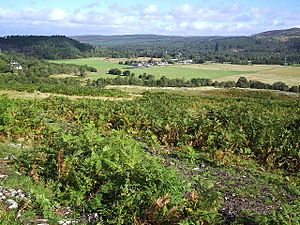Culrain facts for kids
Quick facts for kids Culrain |
|
|---|---|
 Culrain |
|
| Population | 90 (2001) |
| OS grid reference | NH5794 |
| Council area | |
| Country | Scotland |
| Sovereign state | United Kingdom |
| Post town | ARDGAY |
| Postcode district | IV24 |
| Police | Northern |
| Fire | Highlands and Islands |
| Ambulance | Scottish |
| EU Parliament | Scotland |
Culrain is a small village in the Highland area of Scotland. It's located in Sutherland, a beautiful part of the country. This quiet village has a rich history. It includes important events like a famous battle and big changes to how the land was used long ago.
Contents
Where is Culrain?
Culrain is found west of Ardgay. It sits right next to the Kyle of Sutherland. This is where several rivers meet. They flow into the sea through green meadows. It's about 5 kilometers (3 miles) west of the village of Bonar Bridge. Culrain is part of the Kincardine civil parish.
Culrain's Past
A Battle Long Ago: The Battle of Carbisdale
In 1650, a big battle happened near Culrain. It was called the Battle of Carbisdale. A famous leader named James Graham, 1st Marquess of Montrose was defeated here. This battle was a major turning point for him. Even though the battle is named after Carbisdale farm, Culrain is the closest village to the site.
The Munro Family and the Estate
The Munro of Culrain family owned the land here in the 1600s. The estate was apparently named after Coleraine in Ireland. This was because an ancestor, George Munro, 1st of Newmore, had been a governor there. Later, the estate passed to the Munro of Novar family.
The Highland Clearances in Culrain
A man named Hugh Andrew Johnstone Munro of Novar owned the Culrain estate. He was more interested in art than politics. However, during his time, a big event called the Highland Clearances was happening. This was when many people were moved off their land.
In 1820, Munro of Novar decided to move tenants from his Culrain estate. At first, a group of officials tried to deliver "notices of removal." But about 150 women confronted them. The women took the papers and stopped the officials. They were armed with sticks. During this event, one official was punched by a woman. He ran off, and the women drove the others out of Culrain.
Munro of Novar then sent a larger group of about 100 men. This group included armed former soldiers. On March 2, 1820, they also faced resistance from the women. The women threw stones at them. During this clash, some people were hurt.
After these events, Munro of Novar made an agreement. He said his tenants would not be moved. The land would still be used for sheep farming. However, this agreement did not last. Later in 1820, he moved between 500 and 600 people from his Culrain estate. This was to make way for sheep.
Ann Henderson, the Sculptor
For some years, Culrain was also home to a Scottish sculptor. Her name was Ann Henderson. She was a member of the Royal Scottish Academy (RSA).
Nearby Places to See
Overlooking the Kyle of Sutherland is Carbisdale Castle. This castle was built in the early 1900s. It was home to the exiled King of Norway. He stayed there during the German occupation of Norway in World War II.
Getting Around
You can travel to Culrain by train. Trains between Inverness and Thurso stop at Ardgay railway station and Culrain railway station. Culrain station is a "request stop," meaning the train only stops if you ask.
Buses also run between Inverness and Lairg. They stop in Ardgay and Bonar Bridge.


